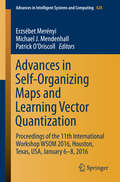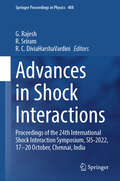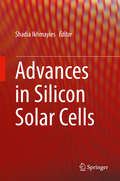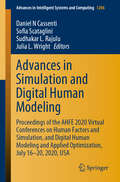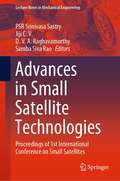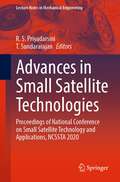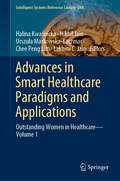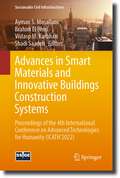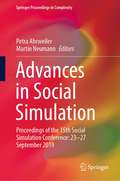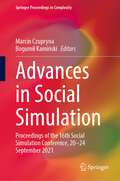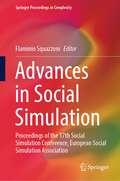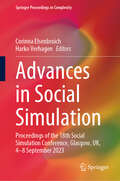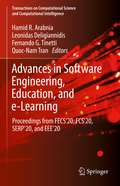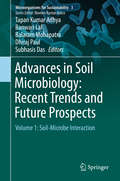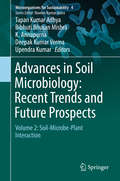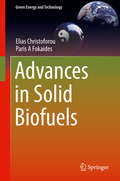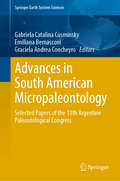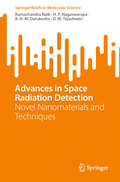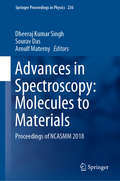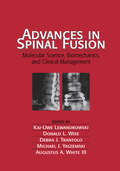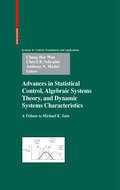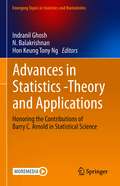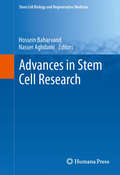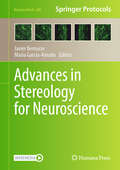- Table View
- List View
Advances in Self-Organizing Maps and Learning Vector Quantization: Proceedings of the 11th International Workshop WSOM 2016, Houston, Texas, USA, January 6-8, 2016 (Advances in Intelligent Systems and Computing #428)
by Erzsébet Merényi Michael J. Mendenhall Patrick O'DriscollThis book contains the articles from the international conference 11th Workshop on Self-Organizing Maps 2016 (WSOM 2016), held at Rice University in Houston, Texas, 6-8 January 2016. WSOM is a biennial international conference series starting with WSOM'97 in Helsinki, Finland, under the guidance and direction of Professor Tuevo Kohonen (Emeritus Professor, Academy of Finland). WSOM brings together the state-of-the-art theory and applications in Competitive Learning Neural Networks: SOMs, LVQs and related paradigms of unsupervised and supervised vector quantization. The current proceedings present the expert body of knowledge of 93 authors from 15 countries in 31 peer reviewed contributions. It includes papers and abstracts from the WSOM 2016 invited speakers representing leading researchers in the theory and real-world applications of Self-Organizing Maps and Learning Vector Quantization: Professor Marie Cottrell (Universite Paris 1 Pantheon Sorbonne, France), Professor Pablo Estevez (University of Chile and Millennium Instituteof Astrophysics, Chile), and Professor Risto Miikkulainen (University of Texas at Austin, USA). The book comprises a diverse set of theoretical works on Self-Organizing Maps, Neural Gas, Learning Vector Quantization and related topics, and an excellent variety of applications to data visualization, clustering, classification, language processing, robotic control, planning, and to the analysis of astronomical data, brain images, clinical data, time series, and agricultural data.
Advances in Shock Interactions: Proceedings of the 24th International Shock Interaction Symposium, SIS-2022, 17-20 October, Chennai, India (Springer Proceedings in Physics #408)
by G. Rajesh R. Sriram R. C. DiviaHarshaVardiniThis book is a collection of the technical papers presented in the 24th International Shock Interaction Symposium. The main topics include• Shock wave diffraction• Shock wave reflections and refraction on interfaces• Shock wave-boundary layer interaction• Shock wave-shear layer interaction• Shock wave-vortex interaction• Shock wave-bubble interaction• Shock wave-contact surface interaction• Shock wave diffraction over bodies or obstacles• Shock waves in rarefied flows• Shock waves in MHD flows• Dynamics of the explosion, blast waves, and detonations• Shock wave propagation in condensed and heterogeneous materials• Shock waves in high-enthalpy facilities• High-speed flow diagnostics
Advances in Silicon Solar Cells
by Shadia IkhmayiesThis book provides a review of all types of silicon solar cells. The scope includes monocrocrystalline Si solar cells, polycrystalline and amorphous thin-film silicon solar cells, and tandem solar cells. Production, treatment and development of these devices are reviewed. Limitations of these devices, design optimization, testing and fabrication methods are covered. In addition, current status and future prospects for the further development of silicon solar cells are addressed. Special emphasis is given to methods of attaining high efficiency and thereby cost-effective solar power. The aim of the book is to provide the reader with a complete overview about the recent advances in the structure and technology of all generations of silicon solar cells.
Advances in Simulation and Digital Human Modeling: Proceedings of the AHFE 2020 Virtual Conferences on Human Factors and Simulation, and Digital Human Modeling and Applied Optimization, July 16-20, 2020, USA (Advances in Intelligent Systems and Computing #1206)
by Daniel N Cassenti Sofia Scataglini Sudhakar L. Rajulu Julia L. WrightThis book presents the latest advances in modeling and simulation for human factors research. It reports on cutting-edge simulators such as virtual and augmented reality, multisensory environments, and modeling and simulation methods used in various applications, including surgery, military operations, occupational safety, sports training, education, transportation and robotics. Based on two AHFE 2020 Virtual Conferences such as the AHFE 2020 Virtual Conference on Human Factors and Simulation and the AHFE 2020 Virtual Conference on Digital Human Modeling and Applied Optimization, held on July 16–20, 2020, the book serves as a timely reference guide for researchers and practitioners developing new modeling and simulation tools for analyzing or improving human performance. It also offers a unique resource for modelers seeking insights into human factors research and more feasible and reliable computational tools to foster advances in this exciting field.
Advances in Small Satellite Technologies: Proceedings of 1st International Conference on Small Satellites (Lecture Notes in Mechanical Engineering)
by Psr Srinivasa Sastry Jiji C. V. D. V. A. Raghavamurthy Samba Siva RaoThis volume contains select papers presented during the 1st International Conference on Small Satellites, discussing the latest research and developments relating to small satellite technology. The papers cover various issues relating to design and engineering, ranging from the control, mechanical and thermal systems to the sensors, antennas and RF systems used. The volume will be of interest to scientists and engineers working on or utilizing satellite and space technologies.
Advances in Small Satellite Technologies: Proceedings of National Conference on Small Satellite Technology and Applications, NCSSTA 2020 (Lecture Notes in Mechanical Engineering)
by R. S. Priyadarsini T. SundararajanThis book contains select papers presented during the 2nd National Conference on Small Satellites, discussing the latest research and developments relating to small satellite technology. The papers cover various issues relating to design and engineering, ranging from the control, mechanical, and thermal systems to the sensors, antennas, and RF systems used. The book is of interest to scientists and engineers working on or utilizing satellite and space technologies.
Advances in Smart Healthcare Paradigms and Applications: Outstanding Women in Healthcare—Volume 1 (Intelligent Systems Reference Library #244)
by Lakhmi C. Jain Chee Peng Lim Halina Kwaśnicka Nikhil Jain Urszula Markowska-KaczmarThis book is dedicated to showcase research and innovation in smart healthcare systems and technologies led by women scientists, researchers, and practitioners. With the advent of artificial intelligence (AI) and related technologies, the healthcare sector has undergone tremendous changes in practice and management in recent years. On par to men, women have made significant contributions to tackle a variety of healthcare problems, creating smarter paradigms to provide effective and efficient solutions for patients and stakeholders. The book presents a small collection of contributions by outstanding women in STEM (Science, Technology, Engineering and Mathematics) education, focusing on the healthcare domain. The selected articles allow readers to comprehend current advances in AI and other methods for undertaking healthcare challenges. It is envisaged that the inspiring work by prominent women scientists, researchers, and practitioners reported in this book offers a beacon to propel women in pursuing STEM education and advancing the healthcare sector for the benefits of humankind.
Advances in Smart Materials and Innovative Buildings Construction Systems: Proceedings of the 4th International Conference on Advanced Technologies for Humanity (ICATH'2022) (Sustainable Civil Infrastructures)
by Brahim El Bhiri Ayman S. Mosallam Vistasp M. Karbhari Shadi SaadehThis book contains a comprehensive guide to the latest developments in building and bridge construction. The book covers a wide range of topics, including the use of advanced materials such as fiber-reinforced polymer (FRP) composites and the incorporation of smart technologies into design and construction of buildings and bridges.The book discusses advantages of using FRP composites in building and bridge construction. It then goes on to explore the use of smart technologies, such as sensors and structural health monitoring systems, to improve performance and safety of structures. It also covers the use of advanced concrete and masonry materials and methods, including high-performance concrete, self-consolidating concrete, and advanced masonry systems.The book is written for engineers, architects, and construction professionals and provides a detailed overview of the latest research and developments in the field. It includes case studies and practical examples to illustrate key concepts and techniques, making it an invaluable resource for those involved in building and bridge construction. With its comprehensive coverage of the latest advances in building and bridge construction, "Advances in Concrete, Masonry and FRP Composite Smart Buildings and Bridges" is an essential guide for anyone looking to stay current with the latest trends and technologies in the industry.
Advances in Social Simulation: Proceedings of the 15th Social Simulation Conference: 23–27 September 2019 (Springer Proceedings in Complexity)
by Martin Neumann Petra AhrweilerThis book presents the state of the art in social simulation as presented at the Social Simulation Conference 2019 in Mainz, Germany. It covers the developments in applications and methods of social simulation, addressing societal issues such as socio-ecological systems and policymaking. Methodological issues discussed include large-scale empirical calibration, model sharing and interdisciplinary research, as well as decision-making models, validation and the use of qualitative data in simulation modeling. Research areas covered include archaeology, cognitive science, economics, organization science and social simulation education.This book gives readers insight into the increasing use of social simulation in both its theoretical development and in practical applications such as policymaking whereby modeling and the behavior of complex systems is key. The book appeals to students, researchers and professionals in the various fields.
Advances in Social Simulation: Proceedings of the 16th Social Simulation Conference, 20–24 September 2021 (Springer Proceedings in Complexity)
by Bogumił Kamiński Marcin CzuprynaThis book covers the latest advances in applying agent-based modelling in social sciences. The Social Simulation Conference is the major global conference devoted to this topic. It is aimed at promoting social simulation and computational social science. This year’s special theme is “Social Simulation geared towards Post-Pandemic times”, focused not only on questions raised by the current pandemic but also on future challenges related to economic recovery, such as localization, globalization, inequality, sustainable growth and social changes induced by progressive digitalization, data availability and artificial intelligence. The primary audience of this book are scholars and practitioners in computational social sciences including economics, business, sociology, politics, psychology and urban studies.
Advances in Social Simulation: Proceedings of the 17th Social Simulation Conference, European Social Simulation Association (Springer Proceedings in Complexity)
by Flaminio SquazzoniThis book highlights recent developments in the field of computer simulation and its application to social dynamics and behaviour. It covers latest advancements in the use of agent-based modelling by focusing on thematic issues, methodological progress and applications, including policy, industry and business. It aims to promote this interdisciplinary type of research by showing synergies, complementary and integration especially between computer sciences, social sciences, economics and organization, often bridging qualitative and quantitative research. The primary audience of this book are academics, practitioners and professionals using computer simulation for business counselling or industry.
Advances in Social Simulation: Proceedings of the 18th Social Simulation Conference, Glasgow, UK, 4–8 September 2023 (Springer Proceedings in Complexity)
by Corinna Elsenbroich Harko VerhagenThis book contains the proceedings of the 18th Social Simulation Conference (SSC) and covers the state of the art of social simulation modeling. The SSC is the annual conference of the European Social Simulation Association (ESSA) and the major global conference devoted to this topic. It is aimed at promoting social simulation and computational social science. The book is the biggest collection of agent-based modeling research. It covers all aspects of modeling, from theory and philosophy of modeling to question of model design, purpose, and structure, using data, visualization, model interrelation, and open modeling. This book is targeted at researchers in social simulation regardless of disciplinary backgrounds, across career stages and different sectors, such as academia, industry, and policy
Advances in Software Engineering, Education, and e-Learning: Proceedings from FECS'20, FCS'20, SERP'20, and EEE'20 (Transactions on Computational Science and Computational Intelligence)
by Hamid R. Arabnia Quoc-Nam Tran Leonidas Deligiannidis Fernando G. TinettiThis book presents the proceedings of four conferences: The 16th International Conference on Frontiers in Education: Computer Science and Computer Engineering + STEM (FECS'20), The 16th International Conference on Foundations of Computer Science (FCS'20), The 18th International Conference on Software Engineering Research and Practice (SERP'20), and The 19th International Conference on e-Learning, e-Business, Enterprise Information Systems, & e-Government (EEE'20). The conferences took place in Las Vegas, NV, USA, July 27-30, 2020 as part of the larger 2020 World Congress in Computer Science, Computer Engineering, & Applied Computing (CSCE'20), which features 20 major tracks. Authors include academics, researchers, professionals, and students. This book contains an open access chapter entitled, "Advances in Software Engineering, Education, and e-Learning".Presents the proceedings of four conferences as part of the 2020 World Congress in Computer Science, Computer Engineering, & Applied Computing (CSCE'20);Includes the tracks Computer Engineering + STEM, Foundations of Computer Science, Software Engineering Research, and e-Learning, e-Business, Enterprise Information Systems, & e-Government;Features papers from FECS'20, FCS'20, SERP'20, EEE'20, including one open access chapter.
Advances in Soil Microbiology: Volume 1: Soil-microbe Interaction (Microorganisms For Sustainability #3)
by Tapan Kumar Adhya Banwari Lal Balaram Mohapatra Dhiraj Paul Subhasis DasThis book presents a comprehensive collection of articles illustrating the importance of microbial community structure and function for ecosystem sustainability and environmental reclamation. It addresses a diverse range of topics, including microbial diversity, physiology, genomics, ecosystem function, interaction, metabolism, and the fruitful use of microbial communities for crop productivity and environmental remediation. <P><P> In addition, the book explores issues ranging from general concepts on the diversity of microorganisms in soil, and ecosystem function to the evolution and taxonomy of soil microbiota, with future prospects. It covers cutting-edge methods in soil microbial ecological studies, rhizosphere microflora, the role of organic matter in plant productivity, biological nitrogen fixation and its genetics, microbial transformation of plant nutrients in soil, plant-growth-promoting rhizobacteria, and organic matter transformation. <P> The book also discusses the application of microbes in biodegradation of xenobiotic contaminants. It covers bio-fertilizers and their role in sustainable agriculture and soil health, biological control of insect pests and plant pathogens, and the latest tools of omics in soil microbiology, i.e. genomics, proteomics, transcriptomics and metabolomics, which offer pioneering approaches to the exploration of microbial structure and function.
Advances in Soil Microbiology: Volume 2: Soil-Microbe-Plant Interaction (Microorganisms for Sustainability #4)
by K. Annapurna Tapan Kumar Adhya Bibhuti Bhusan Mishra Deepak Kumar Verma Upendra KumarThis book presents a comprehensive collection of articles illustrating the importance of microbial community structure and function for ecosystem sustainability and environmental reclamation. It addresses a diverse range of topics, including microbial diversity, physiology, genomics, ecosystem function, interaction, metabolism, and the fruitful use of microbial communities for crop productivity and environmental remediation. In addition, the book explores issues ranging from general concepts on the diversity of microorganisms in soil, and ecosystem function to the evolution and taxonomy of soil microbiota, with future prospects. It covers cutting-edge methods in soil microbial ecological studies, rhizosphere microflora, the role of organic matter in plant productivity, biological nitrogen fixation and its genetics, microbial transformation of plant nutrients in soil, plant-growth-promoting rhizobacteria, and organic matter transformation. The book also discusses the application of microbes in biodegradation of xenobiotic contaminants. It covers bio-fertilizers and their role in sustainable agriculture and soil health, biological control of insect pests and plant pathogens, and the latest tools of omics in soil microbiology, i. e. genomics, proteomics, transcriptomics and metabolomics, which offer pioneering approaches to the exploration of microbial structure and function.
Advances in Solid Biofuels (Green Energy and Technology)
by Elias Christoforou Paris A FokaidesSolid biofuels, in different trading forms, constitute an integral component of the energy mix of almost all developed and developing countries. Either in the form of pellets, briquettes, chips, firewood, or even as raw feedstock, solid biofuels are used mainly in the heating and power sector. Numerous sustainability concerns, focusing on the environmental, economic and technical aspects of solid biofuels exploitation, led to considerable advances in the recent years in this field. These developments mainly focus on the pre-treatment processes of the solid biomass to biofuels chain, the minimum requirements of the produced solid biofuels, as well as the efficiency and the environmental performance of their thermochemical conversion routes. This work aspires to provide the state of the art in the field of the exploitation of solid biofuels to present the main advances as well as the major challenges of this scientific fields. The topics presented in this book were examined and dealt with by the authors in the past few years, in numerous research projects and scientific publications. This book compiles all the assembled experience of the past few years, and aims to provide an overview of the solid biofuels exploitation field.Presents the latest standards and considerations on solid biofuels technical requirements;Contains numerous examples on applications in the field of solid biofuels thermochemical conversion, as well as the state of the art in this field;Includes sustainability aspects, including life cycle assessment aspects and financial concerns for the exploitation of solid biofuels.
Advances in South American Micropaleontology: Selected Papers of the 11th Argentine Paleontological Congress (Springer Earth System Sciences)
by Gabriela Catalina Cusminsky Emiliana Bernasconi Graciela Andrea ConcheyroThis book offers many examples of calcareous microfossils and describes a new microfaunistic record in Argentina. These selected papers of the 11th Argentine Paleontological Congress include micropaleontological studies on material of different geological ages from several sites in Argentina and Colombia. The authors highlight several geological findings and explain the paleoenvironmental changes in Argentina and Colombia.
Advances in Space Radiation Detection: Novel Nanomaterials and Techniques (SpringerBriefs in Molecular Science)
by H. P. Nagaswarupa Ramachandra Naik B. H. Darukesha D. M. TejashwiniThis brief explores the development and enhancement of space radiation detection systems through the integration of advanced nanomaterials, specifically focusing on metal oxide nanomaterials such as ZrO2. It covers the synthesis, characterization, and thermoluminescence properties of these nanomaterials, as well as their incorporation into plastic scintillators to improve detection efficiency. The book also discusses the challenges and advancements in creating reliable radiation detection technology for space exploration, highlighting potential applications and future directions in the field. It is a useful resource for scientists and graduate students involved in the fields of space exploration, radiation detection technologies, and nanotechnology.
Advances in Spectroscopy: Proceedings of NCASMM 2018 (Springer Proceedings in Physics #236)
by Dheeraj Kumar Singh Sourav Das Arnulf MaternyThis book presents and discusses recent developments in the broad field of spectroscopy, providing the reader with an updated overview. The main objective is to introduce them to recent innovations and current trends in spectroscopy applied to molecules and materials. The book also brings together experimentalists and theoreticians to highlight the multidimensional aspects of spectroscopy and discuss the latest issues. Accordingly, it provides insights not only into the general goals of spectroscopy, but also into how the various spectroscopic techniques represent a toolbox that can be used to gain a more detailed understanding of molecular systems and complex chemical problems. Besides technical aspects, basic theoretical interpretations of spectroscopic results are also presented. The spectroscopy techniques discussed include UV-visible absorption spectroscopy, Raman spectroscopy, IR absorption spectroscopy, fluorescence spectroscopy, and time-resolved spectroscopy. In turn, basic tools like lasers and theoretical modeling approaches are also presented. Lastly, applications for the characterization of fundamental properties of molecules (environmental aspects, biomolecules, pharmaceutical drugs, hazardous molecules, etc.) and materials (nanomaterials, nuclear chemistry materials, biomaterials, etc.) are discussed. Given its scope, the book offers a valuable resource for researchers from various branches of science, and presents new techniques that can be applied to their specific problems.
Advances in Spinal Fusion: Molecular Science, BioMechanics, and Clinical Management
by Kai-Uwe LewandrowskiAdvances in Spinal Fusion reveals a new generation of materials and devices for enhanced operations in spinal fusion. This reference showcases emerging research and technologies in areas such as biodegradable implants, drug delivery, stem cell isolation and transfection, cell encapsulation and immobilization, and the design of 2D and 3D scaffolds for cells. It captures a cascade of innovations crucial to increased healing and decreased morbidity in spinal fusion methods and mechanics and addresses current standards in analytical methodology and quality control, it describes the selection of biomaterials for improved biocompatibility, biostability, and structure/function relationships.
Advances in Statistical Bioinformatics: Models and Integrative Inference for High-Throughput Data
by Kim-Anh Do Zhaohui Steve Qin Marina VannucciProviding genome-informed personalized treatment is a goal of modern medicine. Identifying new translational targets in nucleic acid characterizations is an important step toward that goal. The information tsunami produced by such genome-scale investigations is stimulating parallel developments in statistical methodology and inference, analytical frameworks, and computational tools. Within the context of genomic medicine and with a strong focus on cancer research, this book describes the integration of high-throughput bioinformatics data from multiple platforms to inform our understanding of the functional consequences of genomic alterations. This includes rigorous and scalable methods for simultaneously handling diverse data types such as gene expression array, miRNA, copy number, methylation, and next-generation sequencing data. This material is written for statisticians who are interested in modeling and analyzing high-throughput data. Chapters by experts in the field offer a thorough introduction to the biological and technical principles behind multiplatform high-throughput experimentation.
Advances in Statistical Control, Algebraic Systems Theory, and Dynamic Systems Characteristics: A Tribute to Michael K. Sain (Systems & Control: Foundations & Applications)
by Anthony N. Michel Cheryl B. Schrader Chang-Hee WonThis volume is a collection of chapters covering recent advances in stochastic optimal control theory and algebraic systems theory. The book will be a useful reference for researchers and graduate students in systems and control, algebraic systems theory, and applied mathematics. Requiring only knowledge of undergraduate-level control and systems theory, the work may be used as a supplementary textbook in a graduate course on optimal control or algebraic systems theory.
Advances in Statistics - Theory and Applications: Honoring the Contributions of Barry C. Arnold in Statistical Science (Emerging Topics in Statistics and Biostatistics)
by N. Balakrishnan Hon Keung Tony Ng Indranil GhoshThis edited collection brings together internationally recognized experts in a range of areas of statistical science to honor the contributions of the distinguished statistician, Barry C. Arnold. A pioneering scholar and professor of statistics at the University of California, Riverside, Dr. Arnold has made exceptional advancements in different areas of probability, statistics, and biostatistics, especially in the areas of distribution theory, order statistics, and statistical inference. As a tribute to his work, this book presents novel developments in the field, as well as practical applications and potential future directions in research and industry. It will be of interest to graduate students and researchers in probability, statistics, and biostatistics, as well as practitioners and technicians in the social sciences, economics, engineering, and medical sciences.
Advances in Stem Cell Research (Stem Cell Biology and Regenerative Medicine)
by Hossein Baharvand Nasser AghdamiAdvances in Stem Cell Research discusses recent advances in stem cell science, including therapeutic applications. This volume covers such topics as biomanufacturing iPS cells for therapeutic applications, techniques for controlling stem cell fate decisions, as well as current basic research in such areas as germ line stem cells, genomics and proteomics in stem cell research. It is a useful book for biology and clinical scientists, especially young investigators and stem cell biology students who are newly entering the world of stem cells research. The editors hope that the new knowledge and research outlined in this book will help contribute to new therapies for a wide variety of diseases that presently afflict humanity.
Advances in Stereology for Neuroscience (Neuromethods #208)
by Javier Bernacer María García-AmadoThis volume discusses the latest advancements used in various stereological methods to study different neural structures. The chapters in this book cover topics such as microglia measurements, estimation of axonal length, morphological analysis of large nuclei such as the human caudate nucleus, assessments of tissue damage after spinal cord injury in rodents, and the application of automatic stereological methods and artificial intelligence to neural tissue. In the Neuromethods series style, chapters include the kind of detail and key advice from the specialists needed to get successful results in your laboratory. Cutting-edge and comprehensive, Advances in Stereology for Neuroscience is a valuable resource for researchers who are interested in learning more about this important and developing field.
